Leadership Styles And Patient Safety
VerifiedAdded on 2022/09/17
|8
|2085
|17
AI Summary
Contribute Materials
Your contribution can guide someone’s learning journey. Share your
documents today.
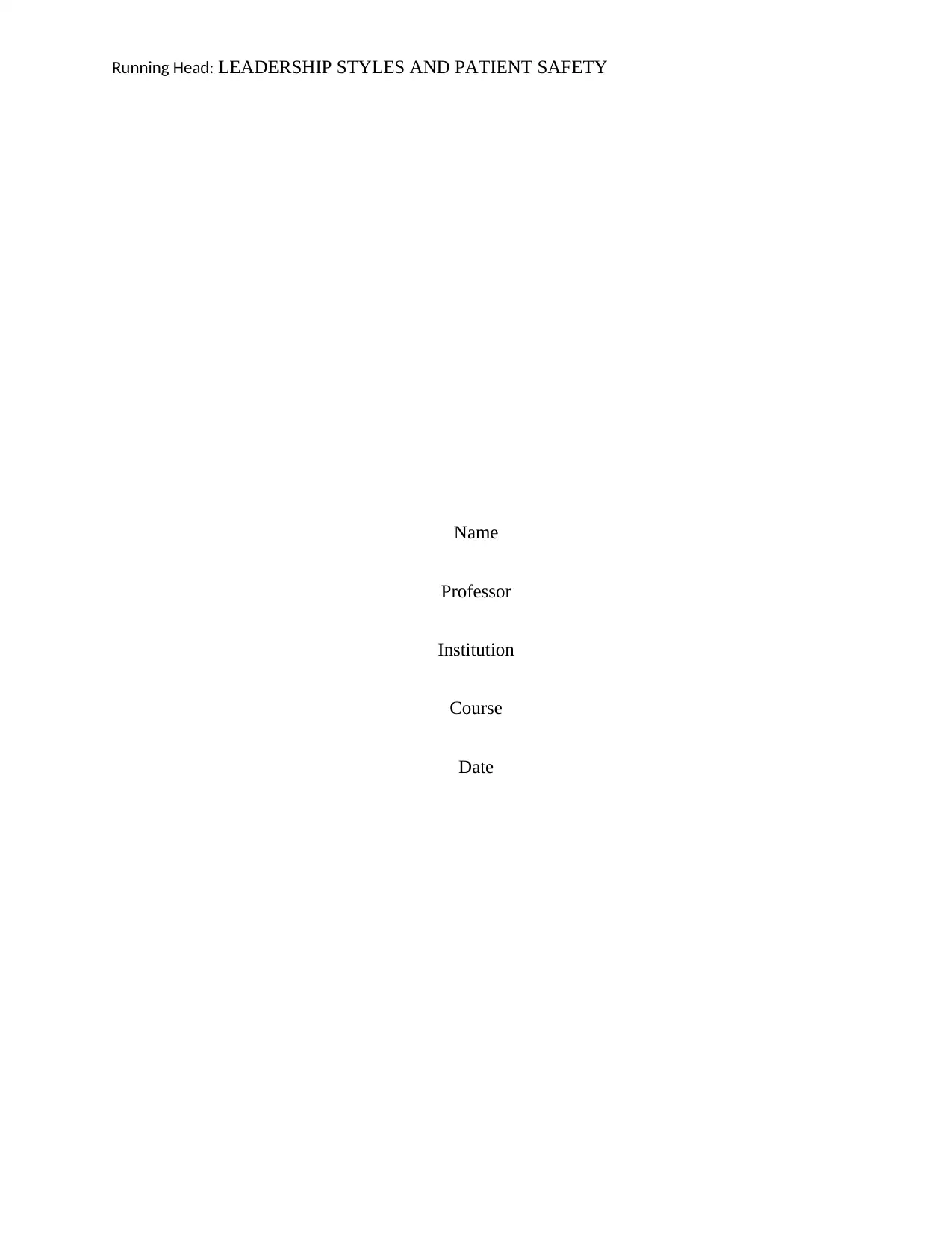
Running Head: LEADERSHIP STYLES AND PATIENT SAFETY
Name
Professor
Institution
Course
Date
Name
Professor
Institution
Course
Date
Secure Best Marks with AI Grader
Need help grading? Try our AI Grader for instant feedback on your assignments.
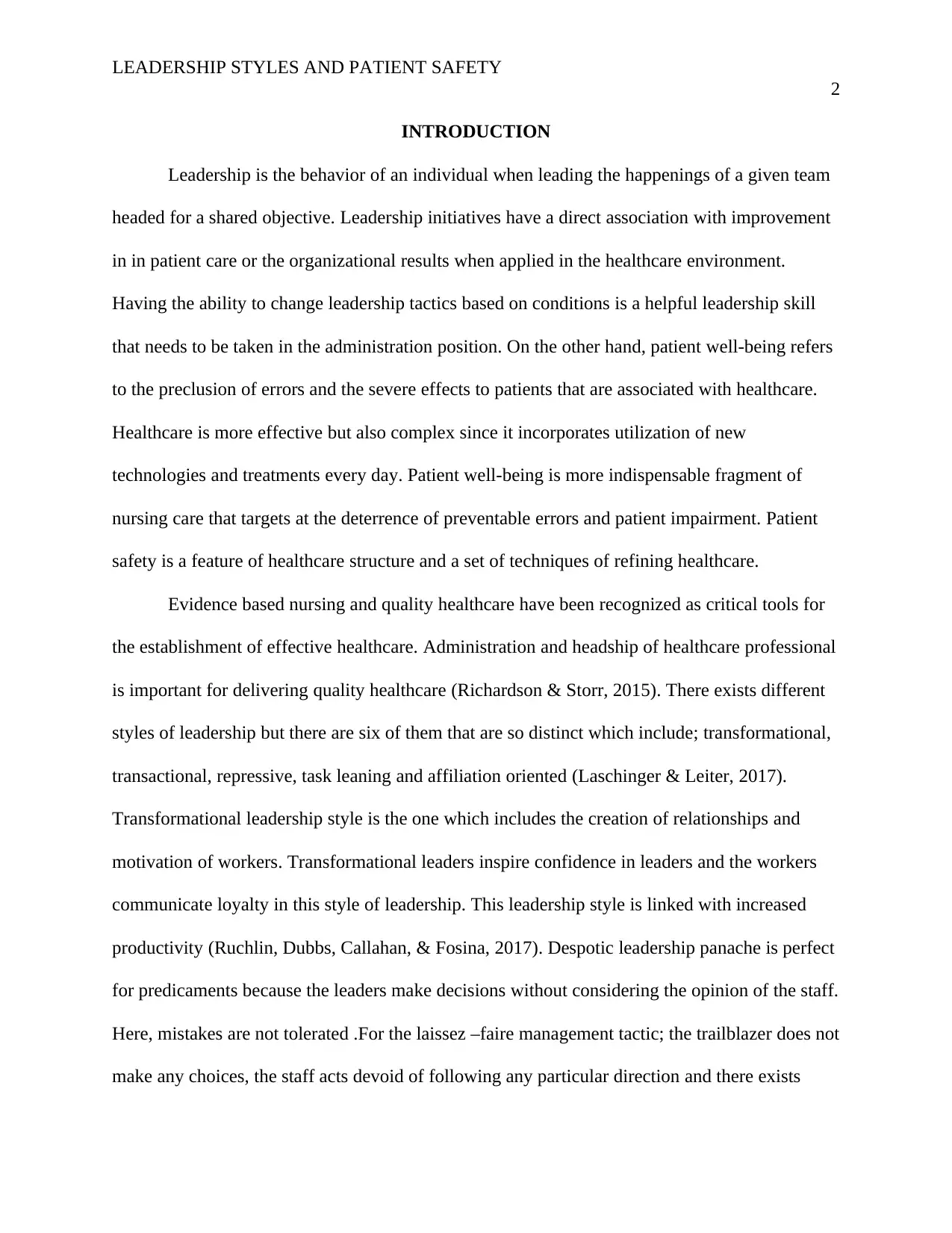
LEADERSHIP STYLES AND PATIENT SAFETY
2
INTRODUCTION
Leadership is the behavior of an individual when leading the happenings of a given team
headed for a shared objective. Leadership initiatives have a direct association with improvement
in in patient care or the organizational results when applied in the healthcare environment.
Having the ability to change leadership tactics based on conditions is a helpful leadership skill
that needs to be taken in the administration position. On the other hand, patient well-being refers
to the preclusion of errors and the severe effects to patients that are associated with healthcare.
Healthcare is more effective but also complex since it incorporates utilization of new
technologies and treatments every day. Patient well-being is more indispensable fragment of
nursing care that targets at the deterrence of preventable errors and patient impairment. Patient
safety is a feature of healthcare structure and a set of techniques of refining healthcare.
Evidence based nursing and quality healthcare have been recognized as critical tools for
the establishment of effective healthcare. Administration and headship of healthcare professional
is important for delivering quality healthcare (Richardson & Storr, 2015). There exists different
styles of leadership but there are six of them that are so distinct which include; transformational,
transactional, repressive, task leaning and affiliation oriented (Laschinger & Leiter, 2017).
Transformational leadership style is the one which includes the creation of relationships and
motivation of workers. Transformational leaders inspire confidence in leaders and the workers
communicate loyalty in this style of leadership. This leadership style is linked with increased
productivity (Ruchlin, Dubbs, Callahan, & Fosina, 2017). Despotic leadership panache is perfect
for predicaments because the leaders make decisions without considering the opinion of the staff.
Here, mistakes are not tolerated .For the laissez –faire management tactic; the trailblazer does not
make any choices, the staff acts devoid of following any particular direction and there exists
2
INTRODUCTION
Leadership is the behavior of an individual when leading the happenings of a given team
headed for a shared objective. Leadership initiatives have a direct association with improvement
in in patient care or the organizational results when applied in the healthcare environment.
Having the ability to change leadership tactics based on conditions is a helpful leadership skill
that needs to be taken in the administration position. On the other hand, patient well-being refers
to the preclusion of errors and the severe effects to patients that are associated with healthcare.
Healthcare is more effective but also complex since it incorporates utilization of new
technologies and treatments every day. Patient well-being is more indispensable fragment of
nursing care that targets at the deterrence of preventable errors and patient impairment. Patient
safety is a feature of healthcare structure and a set of techniques of refining healthcare.
Evidence based nursing and quality healthcare have been recognized as critical tools for
the establishment of effective healthcare. Administration and headship of healthcare professional
is important for delivering quality healthcare (Richardson & Storr, 2015). There exists different
styles of leadership but there are six of them that are so distinct which include; transformational,
transactional, repressive, task leaning and affiliation oriented (Laschinger & Leiter, 2017).
Transformational leadership style is the one which includes the creation of relationships and
motivation of workers. Transformational leaders inspire confidence in leaders and the workers
communicate loyalty in this style of leadership. This leadership style is linked with increased
productivity (Ruchlin, Dubbs, Callahan, & Fosina, 2017). Despotic leadership panache is perfect
for predicaments because the leaders make decisions without considering the opinion of the staff.
Here, mistakes are not tolerated .For the laissez –faire management tactic; the trailblazer does not
make any choices, the staff acts devoid of following any particular direction and there exists
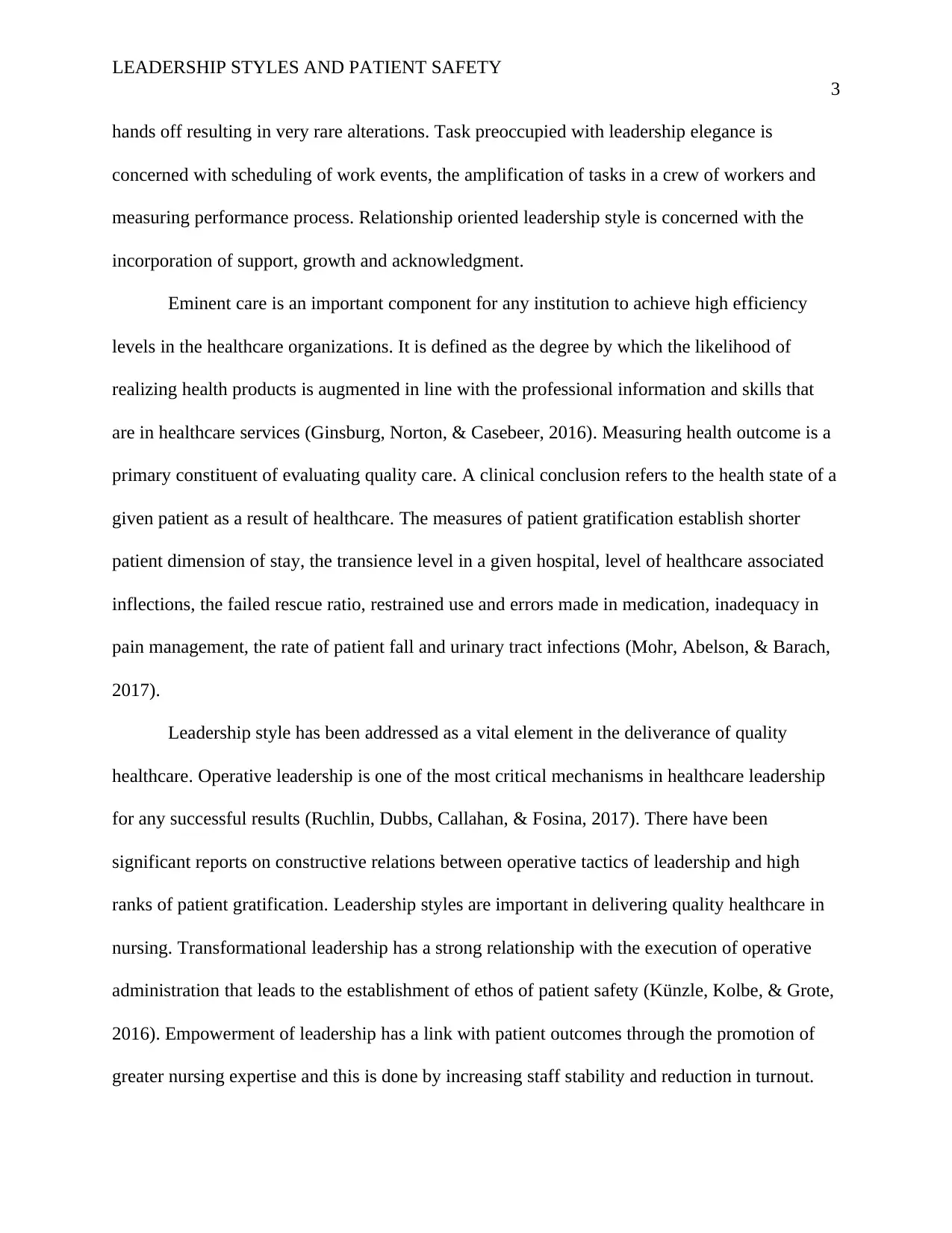
LEADERSHIP STYLES AND PATIENT SAFETY
3
hands off resulting in very rare alterations. Task preoccupied with leadership elegance is
concerned with scheduling of work events, the amplification of tasks in a crew of workers and
measuring performance process. Relationship oriented leadership style is concerned with the
incorporation of support, growth and acknowledgment.
Eminent care is an important component for any institution to achieve high efficiency
levels in the healthcare organizations. It is defined as the degree by which the likelihood of
realizing health products is augmented in line with the professional information and skills that
are in healthcare services (Ginsburg, Norton, & Casebeer, 2016). Measuring health outcome is a
primary constituent of evaluating quality care. A clinical conclusion refers to the health state of a
given patient as a result of healthcare. The measures of patient gratification establish shorter
patient dimension of stay, the transience level in a given hospital, level of healthcare associated
inflections, the failed rescue ratio, restrained use and errors made in medication, inadequacy in
pain management, the rate of patient fall and urinary tract infections (Mohr, Abelson, & Barach,
2017).
Leadership style has been addressed as a vital element in the deliverance of quality
healthcare. Operative leadership is one of the most critical mechanisms in healthcare leadership
for any successful results (Ruchlin, Dubbs, Callahan, & Fosina, 2017). There have been
significant reports on constructive relations between operative tactics of leadership and high
ranks of patient gratification. Leadership styles are important in delivering quality healthcare in
nursing. Transformational leadership has a strong relationship with the execution of operative
administration that leads to the establishment of ethos of patient safety (Künzle, Kolbe, & Grote,
2016). Empowerment of leadership has a link with patient outcomes through the promotion of
greater nursing expertise and this is done by increasing staff stability and reduction in turnout.
3
hands off resulting in very rare alterations. Task preoccupied with leadership elegance is
concerned with scheduling of work events, the amplification of tasks in a crew of workers and
measuring performance process. Relationship oriented leadership style is concerned with the
incorporation of support, growth and acknowledgment.
Eminent care is an important component for any institution to achieve high efficiency
levels in the healthcare organizations. It is defined as the degree by which the likelihood of
realizing health products is augmented in line with the professional information and skills that
are in healthcare services (Ginsburg, Norton, & Casebeer, 2016). Measuring health outcome is a
primary constituent of evaluating quality care. A clinical conclusion refers to the health state of a
given patient as a result of healthcare. The measures of patient gratification establish shorter
patient dimension of stay, the transience level in a given hospital, level of healthcare associated
inflections, the failed rescue ratio, restrained use and errors made in medication, inadequacy in
pain management, the rate of patient fall and urinary tract infections (Mohr, Abelson, & Barach,
2017).
Leadership style has been addressed as a vital element in the deliverance of quality
healthcare. Operative leadership is one of the most critical mechanisms in healthcare leadership
for any successful results (Ruchlin, Dubbs, Callahan, & Fosina, 2017). There have been
significant reports on constructive relations between operative tactics of leadership and high
ranks of patient gratification. Leadership styles are important in delivering quality healthcare in
nursing. Transformational leadership has a strong relationship with the execution of operative
administration that leads to the establishment of ethos of patient safety (Künzle, Kolbe, & Grote,
2016). Empowerment of leadership has a link with patient outcomes through the promotion of
greater nursing expertise and this is done by increasing staff stability and reduction in turnout.
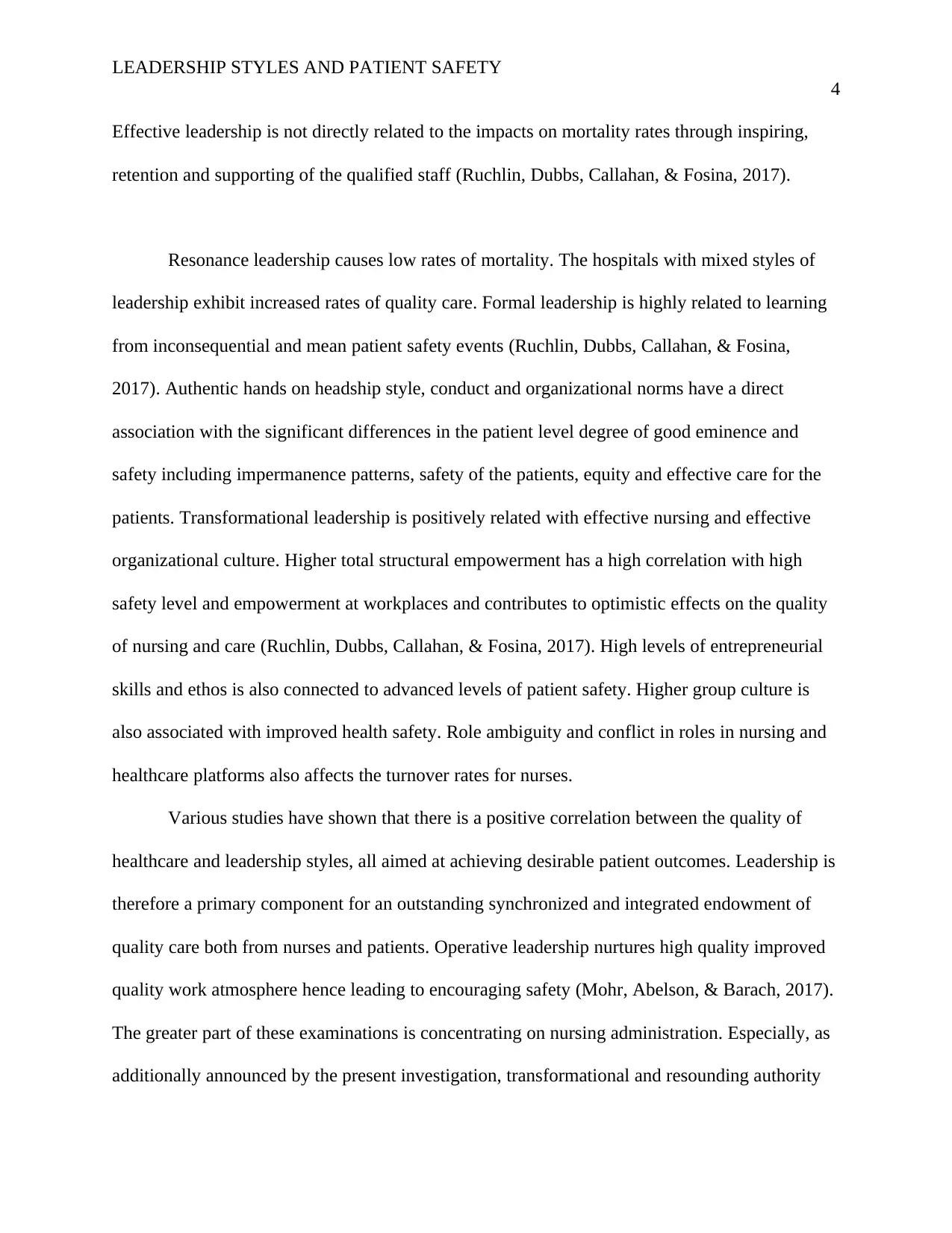
LEADERSHIP STYLES AND PATIENT SAFETY
4
Effective leadership is not directly related to the impacts on mortality rates through inspiring,
retention and supporting of the qualified staff (Ruchlin, Dubbs, Callahan, & Fosina, 2017).
Resonance leadership causes low rates of mortality. The hospitals with mixed styles of
leadership exhibit increased rates of quality care. Formal leadership is highly related to learning
from inconsequential and mean patient safety events (Ruchlin, Dubbs, Callahan, & Fosina,
2017). Authentic hands on headship style, conduct and organizational norms have a direct
association with the significant differences in the patient level degree of good eminence and
safety including impermanence patterns, safety of the patients, equity and effective care for the
patients. Transformational leadership is positively related with effective nursing and effective
organizational culture. Higher total structural empowerment has a high correlation with high
safety level and empowerment at workplaces and contributes to optimistic effects on the quality
of nursing and care (Ruchlin, Dubbs, Callahan, & Fosina, 2017). High levels of entrepreneurial
skills and ethos is also connected to advanced levels of patient safety. Higher group culture is
also associated with improved health safety. Role ambiguity and conflict in roles in nursing and
healthcare platforms also affects the turnover rates for nurses.
Various studies have shown that there is a positive correlation between the quality of
healthcare and leadership styles, all aimed at achieving desirable patient outcomes. Leadership is
therefore a primary component for an outstanding synchronized and integrated endowment of
quality care both from nurses and patients. Operative leadership nurtures high quality improved
quality work atmosphere hence leading to encouraging safety (Mohr, Abelson, & Barach, 2017).
The greater part of these examinations is concentrating on nursing administration. Especially, as
additionally announced by the present investigation, transformational and resounding authority
4
Effective leadership is not directly related to the impacts on mortality rates through inspiring,
retention and supporting of the qualified staff (Ruchlin, Dubbs, Callahan, & Fosina, 2017).
Resonance leadership causes low rates of mortality. The hospitals with mixed styles of
leadership exhibit increased rates of quality care. Formal leadership is highly related to learning
from inconsequential and mean patient safety events (Ruchlin, Dubbs, Callahan, & Fosina,
2017). Authentic hands on headship style, conduct and organizational norms have a direct
association with the significant differences in the patient level degree of good eminence and
safety including impermanence patterns, safety of the patients, equity and effective care for the
patients. Transformational leadership is positively related with effective nursing and effective
organizational culture. Higher total structural empowerment has a high correlation with high
safety level and empowerment at workplaces and contributes to optimistic effects on the quality
of nursing and care (Ruchlin, Dubbs, Callahan, & Fosina, 2017). High levels of entrepreneurial
skills and ethos is also connected to advanced levels of patient safety. Higher group culture is
also associated with improved health safety. Role ambiguity and conflict in roles in nursing and
healthcare platforms also affects the turnover rates for nurses.
Various studies have shown that there is a positive correlation between the quality of
healthcare and leadership styles, all aimed at achieving desirable patient outcomes. Leadership is
therefore a primary component for an outstanding synchronized and integrated endowment of
quality care both from nurses and patients. Operative leadership nurtures high quality improved
quality work atmosphere hence leading to encouraging safety (Mohr, Abelson, & Barach, 2017).
The greater part of these examinations is concentrating on nursing administration. Especially, as
additionally announced by the present investigation, transformational and resounding authority
Secure Best Marks with AI Grader
Need help grading? Try our AI Grader for instant feedback on your assignments.
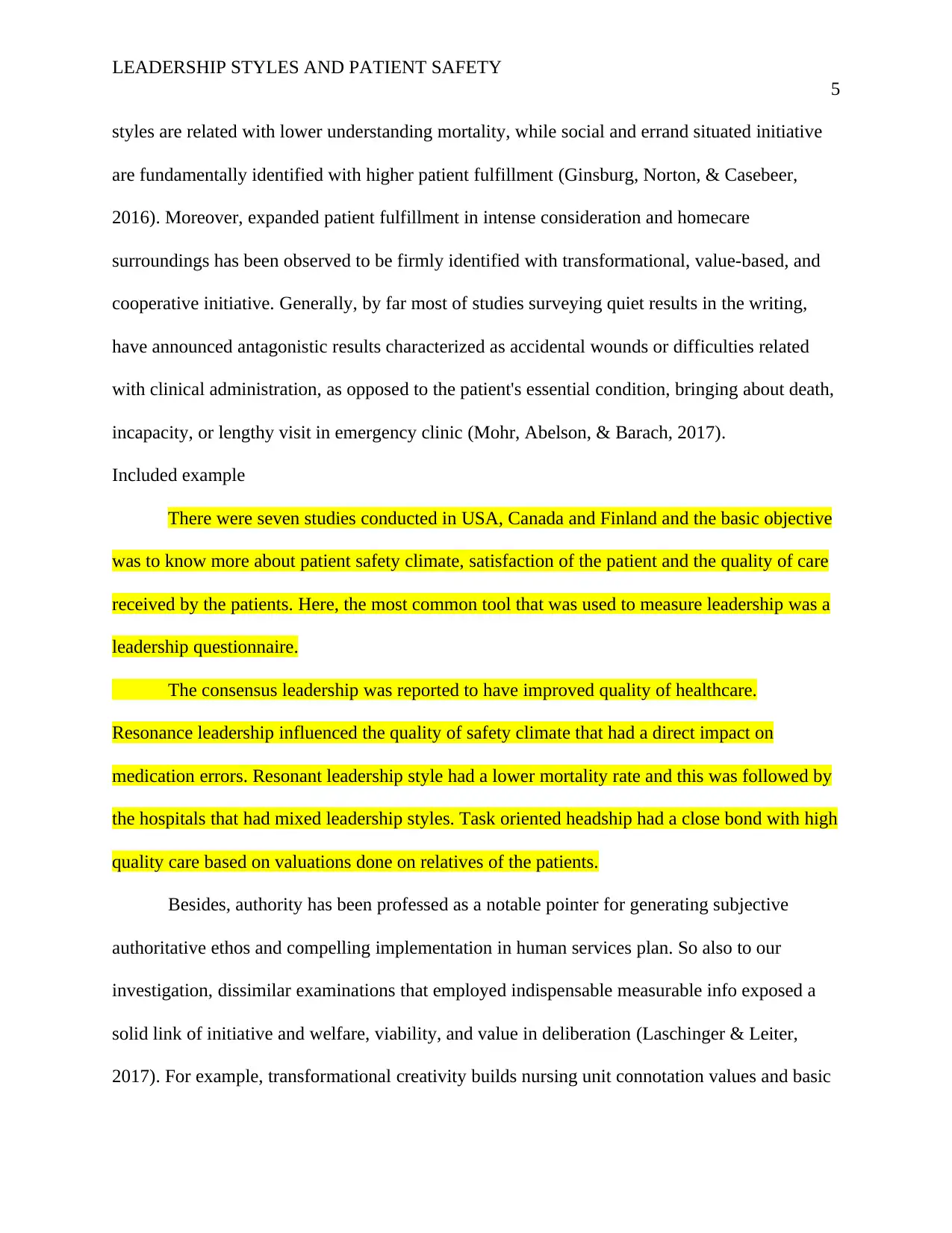
LEADERSHIP STYLES AND PATIENT SAFETY
5
styles are related with lower understanding mortality, while social and errand situated initiative
are fundamentally identified with higher patient fulfillment (Ginsburg, Norton, & Casebeer,
2016). Moreover, expanded patient fulfillment in intense consideration and homecare
surroundings has been observed to be firmly identified with transformational, value-based, and
cooperative initiative. Generally, by far most of studies surveying quiet results in the writing,
have announced antagonistic results characterized as accidental wounds or difficulties related
with clinical administration, as opposed to the patient's essential condition, bringing about death,
incapacity, or lengthy visit in emergency clinic (Mohr, Abelson, & Barach, 2017).
Included example
There were seven studies conducted in USA, Canada and Finland and the basic objective
was to know more about patient safety climate, satisfaction of the patient and the quality of care
received by the patients. Here, the most common tool that was used to measure leadership was a
leadership questionnaire.
The consensus leadership was reported to have improved quality of healthcare.
Resonance leadership influenced the quality of safety climate that had a direct impact on
medication errors. Resonant leadership style had a lower mortality rate and this was followed by
the hospitals that had mixed leadership styles. Task oriented headship had a close bond with high
quality care based on valuations done on relatives of the patients.
Besides, authority has been professed as a notable pointer for generating subjective
authoritative ethos and compelling implementation in human services plan. So also to our
investigation, dissimilar examinations that employed indispensable measurable info exposed a
solid link of initiative and welfare, viability, and value in deliberation (Laschinger & Leiter,
2017). For example, transformational creativity builds nursing unit connotation values and basic
5
styles are related with lower understanding mortality, while social and errand situated initiative
are fundamentally identified with higher patient fulfillment (Ginsburg, Norton, & Casebeer,
2016). Moreover, expanded patient fulfillment in intense consideration and homecare
surroundings has been observed to be firmly identified with transformational, value-based, and
cooperative initiative. Generally, by far most of studies surveying quiet results in the writing,
have announced antagonistic results characterized as accidental wounds or difficulties related
with clinical administration, as opposed to the patient's essential condition, bringing about death,
incapacity, or lengthy visit in emergency clinic (Mohr, Abelson, & Barach, 2017).
Included example
There were seven studies conducted in USA, Canada and Finland and the basic objective
was to know more about patient safety climate, satisfaction of the patient and the quality of care
received by the patients. Here, the most common tool that was used to measure leadership was a
leadership questionnaire.
The consensus leadership was reported to have improved quality of healthcare.
Resonance leadership influenced the quality of safety climate that had a direct impact on
medication errors. Resonant leadership style had a lower mortality rate and this was followed by
the hospitals that had mixed leadership styles. Task oriented headship had a close bond with high
quality care based on valuations done on relatives of the patients.
Besides, authority has been professed as a notable pointer for generating subjective
authoritative ethos and compelling implementation in human services plan. So also to our
investigation, dissimilar examinations that employed indispensable measurable info exposed a
solid link of initiative and welfare, viability, and value in deliberation (Laschinger & Leiter,
2017). For example, transformational creativity builds nursing unit connotation values and basic
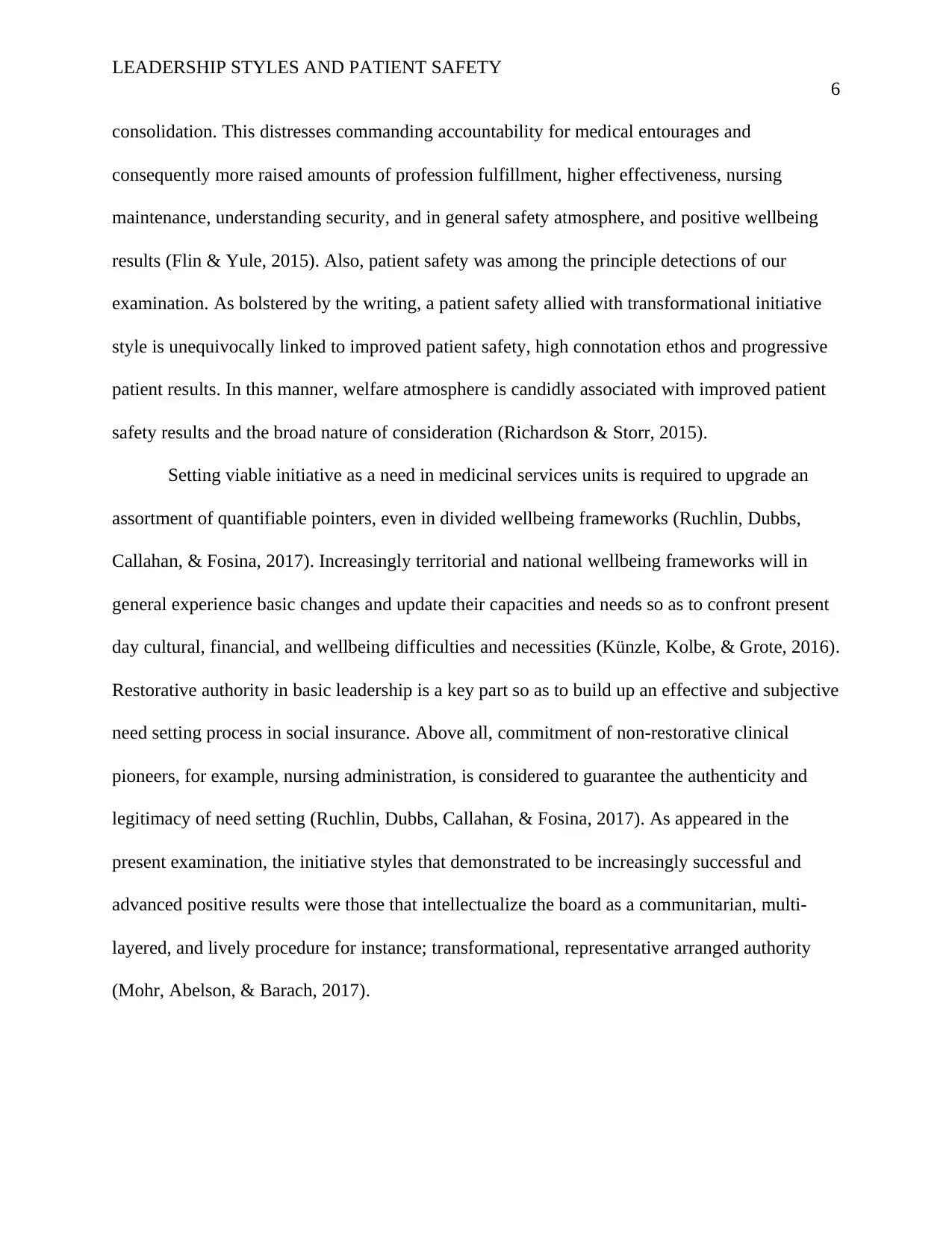
LEADERSHIP STYLES AND PATIENT SAFETY
6
consolidation. This distresses commanding accountability for medical entourages and
consequently more raised amounts of profession fulfillment, higher effectiveness, nursing
maintenance, understanding security, and in general safety atmosphere, and positive wellbeing
results (Flin & Yule, 2015). Also, patient safety was among the principle detections of our
examination. As bolstered by the writing, a patient safety allied with transformational initiative
style is unequivocally linked to improved patient safety, high connotation ethos and progressive
patient results. In this manner, welfare atmosphere is candidly associated with improved patient
safety results and the broad nature of consideration (Richardson & Storr, 2015).
Setting viable initiative as a need in medicinal services units is required to upgrade an
assortment of quantifiable pointers, even in divided wellbeing frameworks (Ruchlin, Dubbs,
Callahan, & Fosina, 2017). Increasingly territorial and national wellbeing frameworks will in
general experience basic changes and update their capacities and needs so as to confront present
day cultural, financial, and wellbeing difficulties and necessities (Künzle, Kolbe, & Grote, 2016).
Restorative authority in basic leadership is a key part so as to build up an effective and subjective
need setting process in social insurance. Above all, commitment of non-restorative clinical
pioneers, for example, nursing administration, is considered to guarantee the authenticity and
legitimacy of need setting (Ruchlin, Dubbs, Callahan, & Fosina, 2017). As appeared in the
present examination, the initiative styles that demonstrated to be increasingly successful and
advanced positive results were those that intellectualize the board as a communitarian, multi-
layered, and lively procedure for instance; transformational, representative arranged authority
(Mohr, Abelson, & Barach, 2017).
6
consolidation. This distresses commanding accountability for medical entourages and
consequently more raised amounts of profession fulfillment, higher effectiveness, nursing
maintenance, understanding security, and in general safety atmosphere, and positive wellbeing
results (Flin & Yule, 2015). Also, patient safety was among the principle detections of our
examination. As bolstered by the writing, a patient safety allied with transformational initiative
style is unequivocally linked to improved patient safety, high connotation ethos and progressive
patient results. In this manner, welfare atmosphere is candidly associated with improved patient
safety results and the broad nature of consideration (Richardson & Storr, 2015).
Setting viable initiative as a need in medicinal services units is required to upgrade an
assortment of quantifiable pointers, even in divided wellbeing frameworks (Ruchlin, Dubbs,
Callahan, & Fosina, 2017). Increasingly territorial and national wellbeing frameworks will in
general experience basic changes and update their capacities and needs so as to confront present
day cultural, financial, and wellbeing difficulties and necessities (Künzle, Kolbe, & Grote, 2016).
Restorative authority in basic leadership is a key part so as to build up an effective and subjective
need setting process in social insurance. Above all, commitment of non-restorative clinical
pioneers, for example, nursing administration, is considered to guarantee the authenticity and
legitimacy of need setting (Ruchlin, Dubbs, Callahan, & Fosina, 2017). As appeared in the
present examination, the initiative styles that demonstrated to be increasingly successful and
advanced positive results were those that intellectualize the board as a communitarian, multi-
layered, and lively procedure for instance; transformational, representative arranged authority
(Mohr, Abelson, & Barach, 2017).
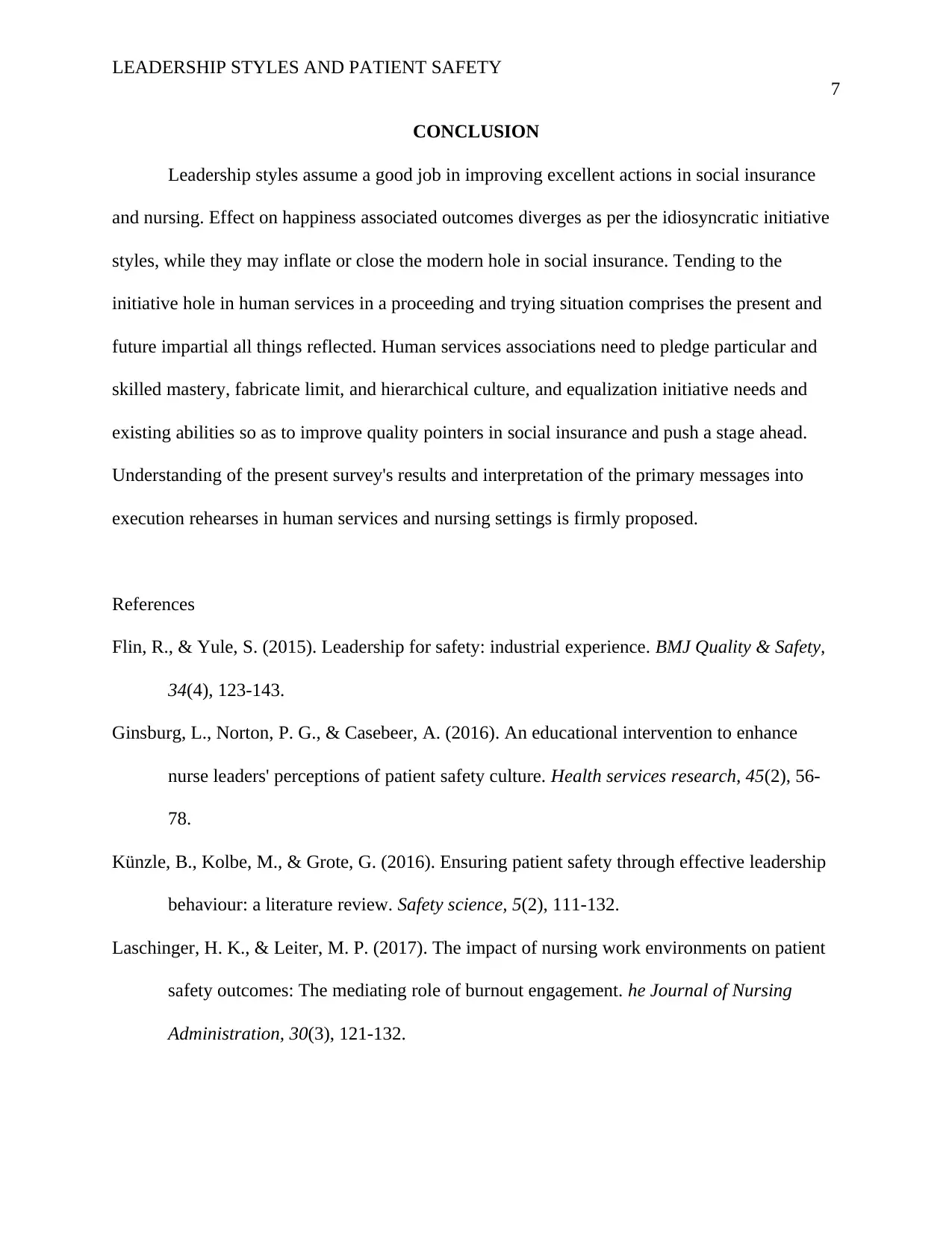
LEADERSHIP STYLES AND PATIENT SAFETY
7
CONCLUSION
Leadership styles assume a good job in improving excellent actions in social insurance
and nursing. Effect on happiness associated outcomes diverges as per the idiosyncratic initiative
styles, while they may inflate or close the modern hole in social insurance. Tending to the
initiative hole in human services in a proceeding and trying situation comprises the present and
future impartial all things reflected. Human services associations need to pledge particular and
skilled mastery, fabricate limit, and hierarchical culture, and equalization initiative needs and
existing abilities so as to improve quality pointers in social insurance and push a stage ahead.
Understanding of the present survey's results and interpretation of the primary messages into
execution rehearses in human services and nursing settings is firmly proposed.
References
Flin, R., & Yule, S. (2015). Leadership for safety: industrial experience. BMJ Quality & Safety,
34(4), 123-143.
Ginsburg, L., Norton, P. G., & Casebeer, A. (2016). An educational intervention to enhance
nurse leaders' perceptions of patient safety culture. Health services research, 45(2), 56-
78.
Künzle, B., Kolbe, M., & Grote, G. (2016). Ensuring patient safety through effective leadership
behaviour: a literature review. Safety science, 5(2), 111-132.
Laschinger, H. K., & Leiter, M. P. (2017). The impact of nursing work environments on patient
safety outcomes: The mediating role of burnout engagement. he Journal of Nursing
Administration, 30(3), 121-132.
7
CONCLUSION
Leadership styles assume a good job in improving excellent actions in social insurance
and nursing. Effect on happiness associated outcomes diverges as per the idiosyncratic initiative
styles, while they may inflate or close the modern hole in social insurance. Tending to the
initiative hole in human services in a proceeding and trying situation comprises the present and
future impartial all things reflected. Human services associations need to pledge particular and
skilled mastery, fabricate limit, and hierarchical culture, and equalization initiative needs and
existing abilities so as to improve quality pointers in social insurance and push a stage ahead.
Understanding of the present survey's results and interpretation of the primary messages into
execution rehearses in human services and nursing settings is firmly proposed.
References
Flin, R., & Yule, S. (2015). Leadership for safety: industrial experience. BMJ Quality & Safety,
34(4), 123-143.
Ginsburg, L., Norton, P. G., & Casebeer, A. (2016). An educational intervention to enhance
nurse leaders' perceptions of patient safety culture. Health services research, 45(2), 56-
78.
Künzle, B., Kolbe, M., & Grote, G. (2016). Ensuring patient safety through effective leadership
behaviour: a literature review. Safety science, 5(2), 111-132.
Laschinger, H. K., & Leiter, M. P. (2017). The impact of nursing work environments on patient
safety outcomes: The mediating role of burnout engagement. he Journal of Nursing
Administration, 30(3), 121-132.
Paraphrase This Document
Need a fresh take? Get an instant paraphrase of this document with our AI Paraphraser
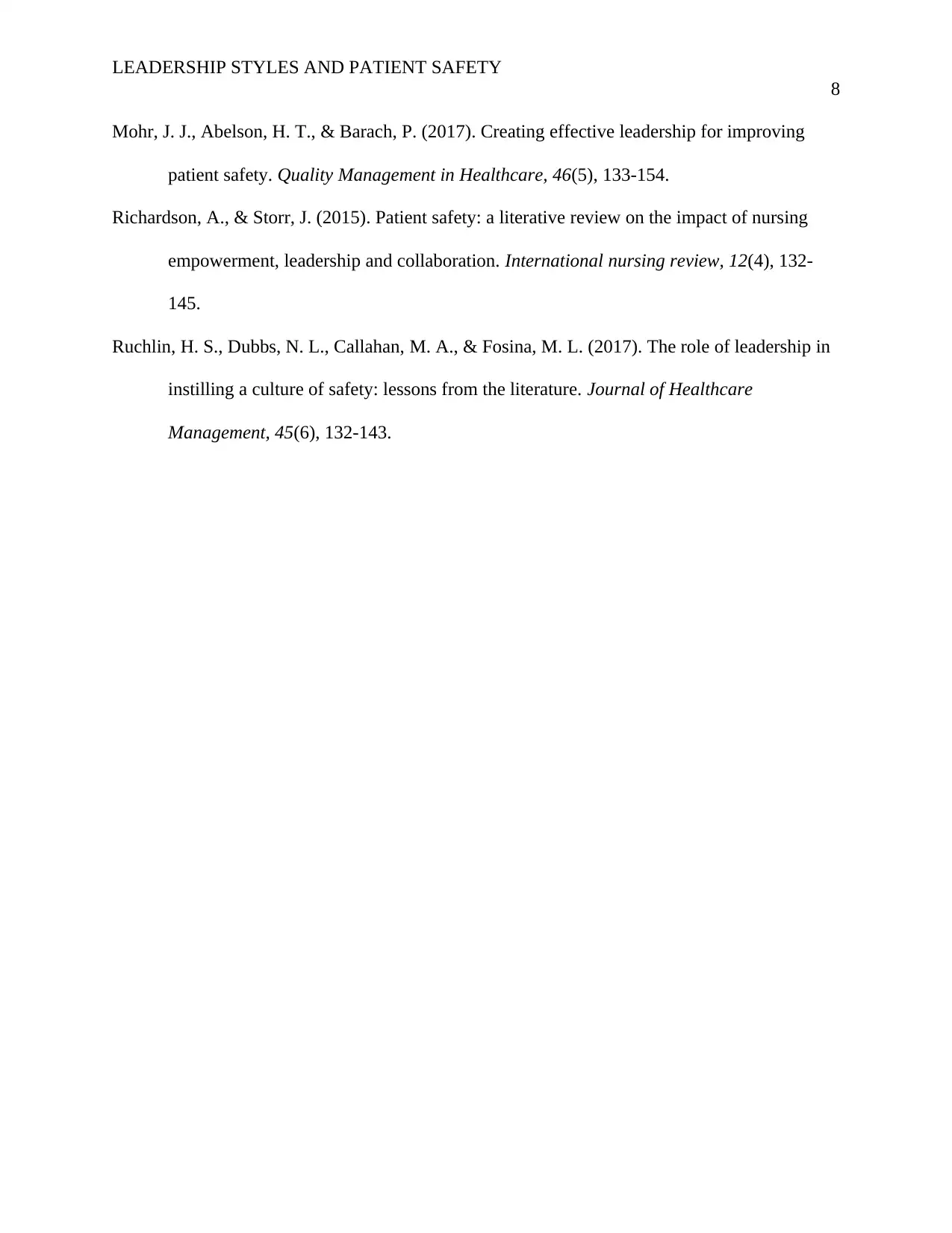
LEADERSHIP STYLES AND PATIENT SAFETY
8
Mohr, J. J., Abelson, H. T., & Barach, P. (2017). Creating effective leadership for improving
patient safety. Quality Management in Healthcare, 46(5), 133-154.
Richardson, A., & Storr, J. (2015). Patient safety: a literative review on the impact of nursing
empowerment, leadership and collaboration. International nursing review, 12(4), 132-
145.
Ruchlin, H. S., Dubbs, N. L., Callahan, M. A., & Fosina, M. L. (2017). The role of leadership in
instilling a culture of safety: lessons from the literature. Journal of Healthcare
Management, 45(6), 132-143.
8
Mohr, J. J., Abelson, H. T., & Barach, P. (2017). Creating effective leadership for improving
patient safety. Quality Management in Healthcare, 46(5), 133-154.
Richardson, A., & Storr, J. (2015). Patient safety: a literative review on the impact of nursing
empowerment, leadership and collaboration. International nursing review, 12(4), 132-
145.
Ruchlin, H. S., Dubbs, N. L., Callahan, M. A., & Fosina, M. L. (2017). The role of leadership in
instilling a culture of safety: lessons from the literature. Journal of Healthcare
Management, 45(6), 132-143.
1 out of 8
Related Documents
Your All-in-One AI-Powered Toolkit for Academic Success.
+13062052269
info@desklib.com
Available 24*7 on WhatsApp / Email
![[object Object]](/_next/static/media/star-bottom.7253800d.svg)
Unlock your academic potential
© 2024 | Zucol Services PVT LTD | All rights reserved.





